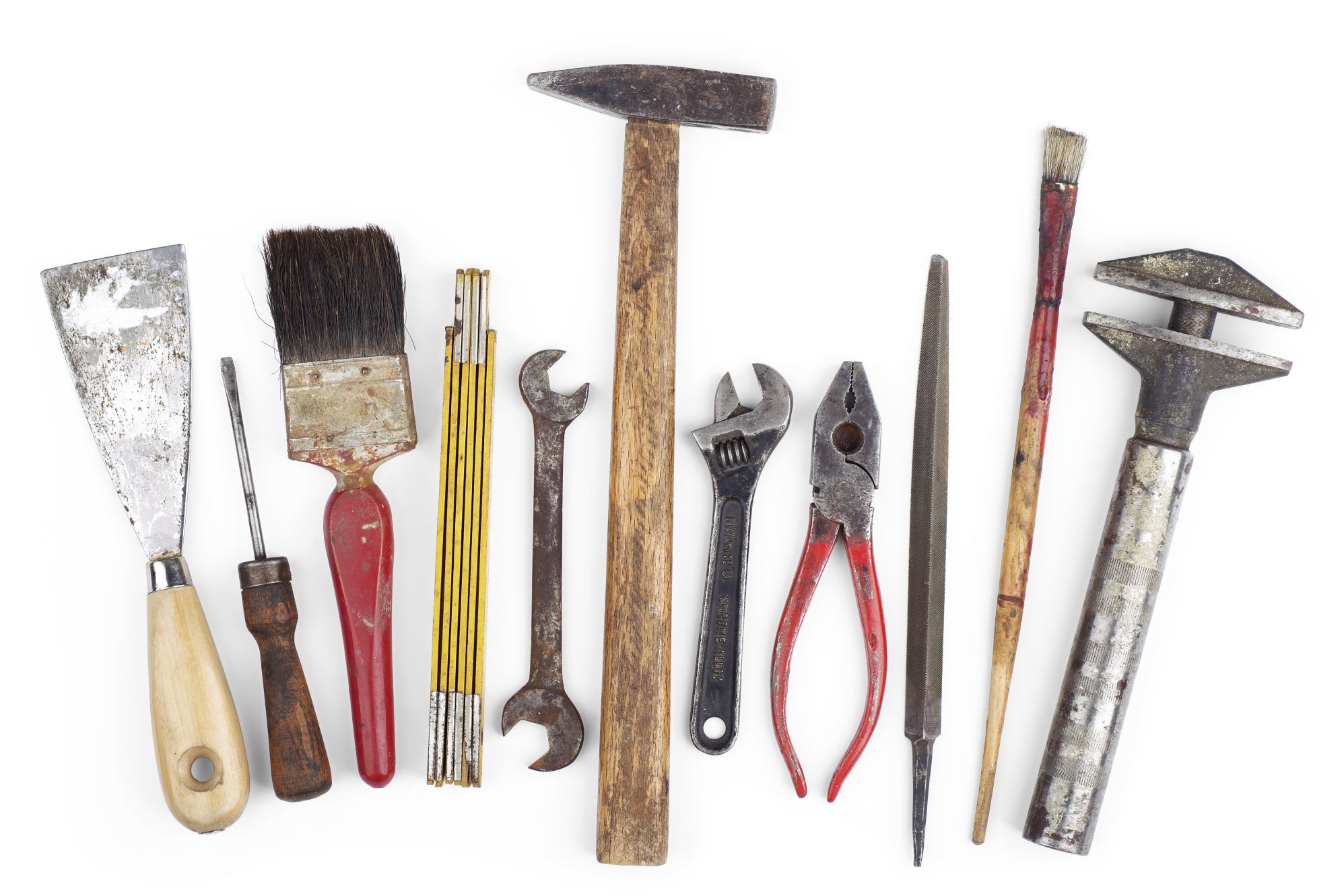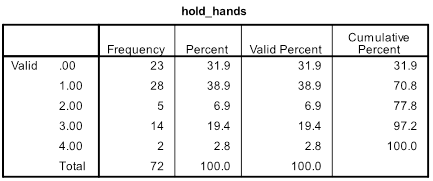Chapter 1. Is Public Affection a Public Affliction?
Introduction
Observational Research
In this activity, you will refine your observational research skills by identifying instances of public displays of affection. You will use these observations to draw conclusions about commonality of displays of affection among couples in public settings.
Dr. Natalie J. Ciarocco, Monmouth University
Dr. David B. Strohmetz, Monmouth University
Dr. Gary W. Lewandowski, Jr., Monmouth University
Something to Think About…

Scenario: It’s Friday night and you’re standing in line, waiting to buy tickets for a movie you’ve been anticipating for months. The line is long, which gives you a chance to watch people. As you scan the crowd, you notice a couple in the next line being overly affectionate, kissing, rubbing noses, giggling, and talking to each other in that goofy voice people who are dating use. Sure, they appear to be in love, but for some reason their behavior comes across to you as sickeningly sweet. Are you predisposed to dislike this behavior, or does it just catch you off-guard? After all, when you were looking at everyone in line, you did not see any other couples acting this way.
Something to Think About…

Public displays of affection occur when a couple engages in acts of physical intimacy in view of others, typically strangers. There are many factors that play a role in how you react to seeing public displays of affection. Observer comfort with such acts varies from person to person and from culture to culture, but your comfort level may depend on which acts a couple publicly displays. Before you can know why people react differently to public displays of affection, you must first identify how often people who appear romantically involved engage in these behaviors.
Our Research Question

Given your observation at the movie theater, you decide to develop a research study to investigate public displays of affection. But first, you need something to guide your exploration of this topic. Research studies all start with a question, so here is your chance to ask one of your own.
Question 1.1
Which of the research questions below would be the best to ask given the goal of your study?
| A. |
| B. |
| C. |
Picking the Best Design

Now that you have established a research question (“How common are public displays of affection?”), you must decide which type of research design best answers your research question. To narrow down your options, consider the following:
Question 1.2
Does your research question focus on what people think or what people do?
| A. |
| B. |
Picking the Best Design

Now that you know a behavioral measure will work best, you must determine which type of behavioral measure to use.
Behavioral Choice
Behavioral Trace
Behavioral Observation
Question 1.3
Given what you know about each type of behavioral measure, which is best given our research question? (“How common are public displays of affection?”)
| A. |
| B. |
| C. |
Picking an Observational Method

If you want to collect data using a behavioral observation, you will need to figure out which type of behavioral observation is best. When in doubt, think back to your research question (“How common are public displays of affection?”). Now, consider the following:
Question 1.4
Is your research about natural, real-life responses?
| A. |
| B. |
Picking an Observational Method

Question 1.5
Next question: Is there a reason for you as the researcher to be directly involved in the action?
| A. |
| B. |
Picking an Observational Method

Here are 3 common types of observations that researchers use:
Naturalistic
Contrived
Participant
Question 1.6
Now that you have considered the factors involved in your observation and know the types of observations researchers use, which of the following types would be best for your study?
| A. |
| B. |
| C. |
Picking an Observational Method

You now know you will not be part of the observation, but how much do the couples you are observing need to know? You must decide whether your observation should be concealed or nonconcealed.
Concealed
Nonconcealed
Question 1.7
Should your observation be concealed or nonconcealed from the participants?
| A. |
| B. |
Developing a Coding System
You are well on your way to completing a naturalistic concealed observation. But before you begin, you are going to need a coding system to keep track of the observations you make.
Coding System
This means you need an operational definition or a description of exactly what you mean by “public displays of affection.”
Given that you want to determine how common public displays of affection are, what behaviors might you observe and record? List 3 behaviors that could be examples of affection seen in public.
Question 1.8
First space for ideas:
Question 1.9
Second space for ideas:
Question 1.10
Third space for ideas:
Developing a Coding System
Now that you know which behaviors you want to observe, you need to determine what aspects of the behaviors you want to code most. Although a certain behavior, such as a kiss, might seem simple, there are many aspects of it that you could analyze. For example, you could complete a duration recording, writing down for how long a couple kisses, or a frequency-count recording, writing down how many times a couple kisses.
Duration Recording
Frequency-Count Recording
Question 1.11
Keeping your research question in mind (“How common are public displays of affection?”), which type of coding would be best?
| A. |
| B. |
Determining Your Hypothesis

Now that you have determined how and what you will observe, you need to think about how the study might turn out.
Question 1.12
Which of the following is the best hypothesis given the nature of your study?
| A. |
| B. |
| C. |
Finding a Sample

Before you can conduct your observation, you need to determine exactly whom you want to observe and where you can find this target sample. In a naturalistic observation, you must find your participants in a place where the behaviors you are interested in (in this case, displays of affection) will occur organically. There are many settings in which your observation could occur, but you are seeking the place that best fits your research needs.
Question 1.13
Which of the following locations do you think would be the best place to observe the target behaviors (public displays of affection)?
| A. |
| B. |
| C. |
| D. |
Submitting to the IRB

Now that you have determined how you will collect your data and your intended sample, you must submit your research procedure to the Institutional Review Board (IRB) for ethical approval. The IRB or ethics board will determine whether or not your study meets all ethical guidelines.
IRB
Each IRB has its own protocol which conforms to the national standard when a researcher submits an application for proposed research to be reviewed. In addition to the appropriate paperwork and other information submitted to the IRB, the board would consider the following description during their evaluation of your proposed experiment:
The purpose of this research is to determine how common public displays of affection are. To study this topic, the researchers will conduct a naturalistic observation at a local coffeehouse. Participants will be unaware of the observations. Research observers will monitor participants’ behaviors from a distance and will not interact with them in any way. During the observations, the researchers will record the number of couples that enter the coffeehouse, as well as the number of times couples engage in a variety of affectionate behaviors.
Responding to the IRB

The IRB reviewed your submission and has a major concern. While they understand that you are observing naturally occurring behaviors and therefore do not need informed consent, they are concerned about observations of people under the age of 18, which is considered a special population by the IRB.
You must now determine how to respond to the IRB, keeping in mind that you want to address their concern while still upholding the quality of your study.
Question 1.14
Which of the following is the best response to the IRB?
| A. |
| B. |
| C. |
Design in Action
With your IRB approval secured, it is time to begin conducting your observation of public displays of affection in the coffeehouse setting. Note how often each behavior you submitted on Screen 11 occurs, and how many couples are present during your observation.
Pilot Testing
What you just did was a pilot test, which is a trial run of a study that researchers use to refine its design, methods, and instruments prior to carrying out the actual research.
Pilot Testing
Take a moment to think about whether your coding system was effective. Did you find the behaviors you were looking for easily? Was the location you chose an adequate place to gather data?
Revising the Coding System
Now that you have practiced collecting observational data on public displays of affection, you likely need to revise and improve your coding system. Researchers rarely get everything right with their original coding system, which is why they pilot it first and then revise it.
| Based on what you saw in the pilot round of coding, which of the following would be the best 3 behaviors to observe and record for frequency? | |
| A. Holding hands | |
| B. Smiling at one another | |
| C. Kissing | |
| D. Hugging | |
| E. Eye gazing | |
Design in Action: Take 2
| Based on what you saw, which of the following would be the best 3 behaviors to observe and record for frequency? | |
| A. Holding hands | |
| B. Smiling at one another | |
| C. Kissing | |
| D. Hugging | |
| E. Eye gazing | |
Collecting Data

Now that you have seen how to conduct observational research and use observational coding, let’s consider what a full version of this study might look like.
If you were to run a full version of this study, you would want to have 2 trained observers spend 45 hours at a local coffeehouse. Having 2 observers helps with the reliability of their observations. The observers would record the number of couples who patronized the coffeehouse and would code the frequency of hand-holding, kissing, and hugging that occurred between couples during the observation. As an example, let’s say that in all, observers coded behavior from 72 couples.
Example Data Set
This is an example of what the data set would look like. The top row shows the variable names; the other rows display the data for the first 10 couples observed.
| Couple Number | Hugs | Kisses | Hand Holds |
| 1 | 0 | 0 | 1 |
| 2 | 1 | 0 | 2 |
| 3 | 0 | 0 | 0 |
| 4 | 0 | 0 | 1 |
| 5 | 0 | 0 | 3 |
| 6 | 1 | 2 | 1 |
| 7 | 0 | 1 | 0 |
| 8 | 0 | 2 | 1 |
| 9 | 0 | 0 | 0 |
| 10 | 0 | 0 | 1 |
Selecting the Proper Tool

Now that you have collected your data, you must decide the best way to summarize your findings. The decisions you made about how to collect your data dictate the statistics you can use with your data now. First, you need to consider if your study is descriptive or inferential.
Descriptive
Inferential
Question 1.15
Given the nature of your observational study, which of the following is the best statistical method for summarizing your study results?
| A. |
| B. |
Tutorial: Evaluating Output

The following is an example of output for another observational study. This study investigated how often people text and call while having dinner in a restaurant.
| Statistics | |||
| Texts | Calls | ||
| N | Valid | 61 | 61 |
| Missing | 0 | 0 | |
| Mean | 1.74 | .74 | |
| Median | 1.00 | 1.00 | |
| Mode | 2 | 0 | |
| Calls | |||||
| Frequency | Percent | Valid Percent | Cumulative Percent | ||
| Valid | 0 | 30 | 49.2 | 49.2 | 49.2 |
| 1 | 17 | 27.9 | 27.9 | 77.0 | |
| 2 | 14 | 23.0 | 23.0 | 100.0 | |
| Total | 61 | 100.0 | 100.0 | ||
| Texts | |||||
| Frequency | Percent | Valid Percent | Cumulative Percent | ||
| Valid | 0 | 11 | 18.0 | 18.0 | 18.0 |
| 1 | 20 | 32.8 | 32.8 | 50.8 | |
| 2 | 24 | 39.3 | 39.3 | 90.2 | |
| 2 | 14 | 23.0 | 23.0 | 100.0 | |
| 4 | 2 | 3.3 | 3.3 | 93.4 | |
| 5 | 1 | 1.6 | 1.6 | 95.1 | |
| 6 | 1 | 1.6 | 1.6 | 96.7 | |
| 7 | 1 | 1.6 | 1.6 | 98.4 | |
| 12 | 1 | 1.6 | 1.6 | 100.0 | |
| Total | 61 | 100.0 | 100.0 | ||
Your Turn: Evaluating Output

Below is the output from your study.




Your Turn: Evaluating Output

Based on the results of your statistical analyses, match the correct number to the term requested:
Please move the correct answer to the left.
Activity: Graphing Results

| Output | |
| Behavior | Mean Frequency |
| Hugging | .750 |
| Kissing | .667 |
| Hand Holding | 1.222 |
Drag the bars in the graph to the correct Mean Frequency.
Mean Frequency.
Affectionate Behaviors
Your Turn: Results

Now that you have worked with your data, you must determine the best way to express your findings in written form. You must be sure that how you describe your findings accurately represents the data itself.
Question 1.16
Based on the statistical analysis, which of the following results sections best fits the data and analyses from your study?
| A. |
| B. |
| C. |
| D. |
Take Home Message

You have determined how to express your findings in a scientifically responsible way. Now, you need to be able to talk about what your findings mean in everyday terms so that the world can benefit from your science.
Question 1.17
How would you explain what you found about public displays of affection to a friend or family member? Select the best option.
| A. |
| B. |
| C. |
| D. |
Congratulations! You have successfully completed this activity.
